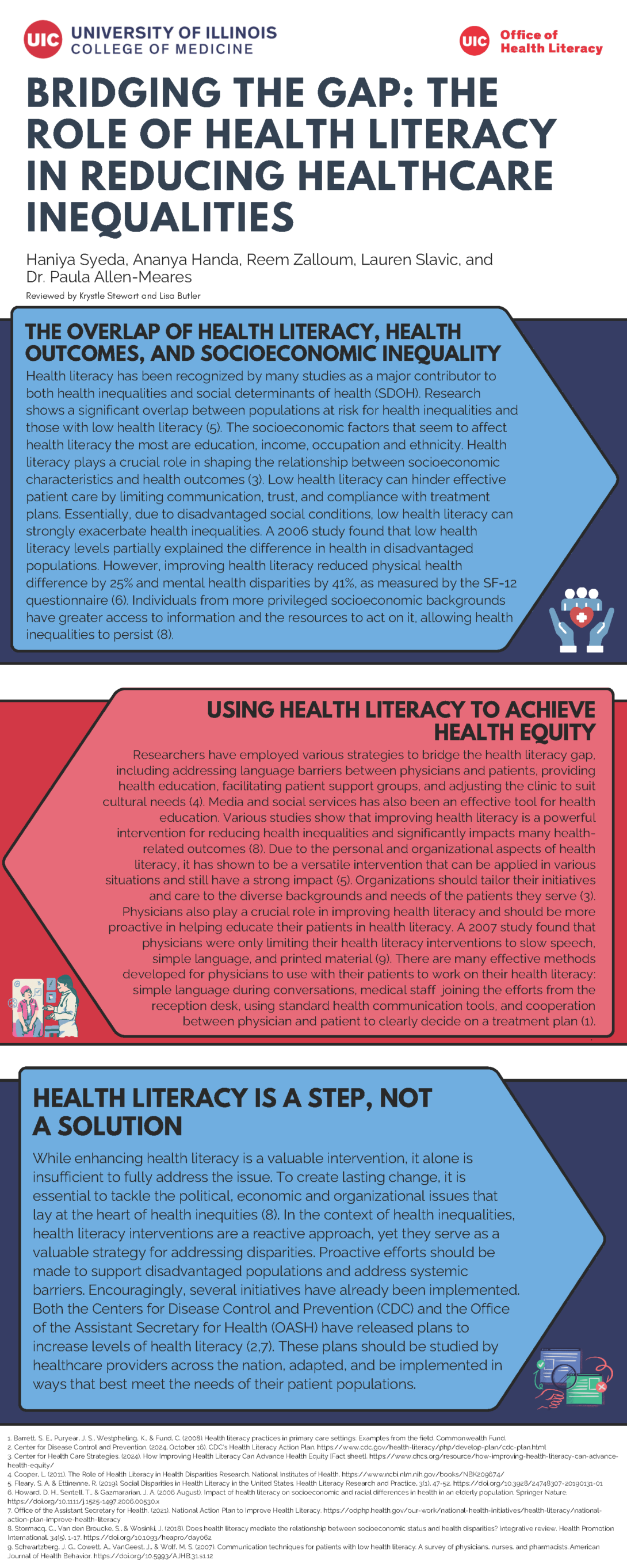Bridging the Gap: The Role of Health Literacy in Reducing Healthcare Inequalities
Haniya Syeda, Ananya Handa, Reem Zalloum, Lauren Slavic, and Dr. Paula Allen-Meares
Published April 1st, 2025. Heading link

The Overlap of Health Literacy, Health Outcomes, and Socioeconomic Inequality
Health literacy has been recognized by many studies as a major contributor to both health inequalities and social determinants of health (SDOH). Research shows a significant overlap between populations at risk for health inequalities and those with low health literacy (5). The socioeconomic factors that seem to affect health literacy the most are education, income, occupation and ethnicity. Health literacy plays a crucial role in shaping the relationship between socioeconomic characteristics and health outcomes (3). Low health literacy can hinder effective patient care by limiting communication, trust, and compliance with treatment plans. Essentially, due to disadvantaged social conditions, low health literacy can strongly exacerbate health inequalities. A 2006 study found that low health literacy levels partially explained the difference in health in disadvantaged populations. However, improving health literacy reduced physical health difference by 25% and mental health disparities by 41%, as measured by the SF-12 questionnaire (6). Individuals from more privileged socioeconomic backgrounds have greater access to information and the resources to act on it, allowing health inequalities to persist (8).
Using Health Literacy to Achieve Health Equity
Researchers have employed various strategies to bridge the health literacy gap, including addressing language barriers between physicians and patients, providing health education, facilitating patient support groups, and adjusting the clinic to suit cultural needs (4). Media and social services has also been an effective tool for health education. Various studies show that improving health literacy is a powerful intervention for reducing health inequalities and significantly impacts many health-related outcomes (8). Due to the personal and organizational aspects of health literacy, it has shown to be a versatile intervention that can be applied in various situations and still have a strong impact (5). Organizations should tailor their initiatives and care to the diverse backgrounds and needs of the patients they serve (3). Physicians also play a crucial role in improving health literacy and should be more proactive in helping educate their patients in health literacy. A 2007 study found that physicians were only limiting their health literacy interventions to slow speech, simple language, and printed material (9). There are many effective methods developed for physicians to use with their patients to work on their health literacy: simple language during conversations, medical staff joining the efforts from the reception desk, using standard health communication tools, and cooperation between physician and patient to clearly decide on a treatment plan (1).
Health Literacy is a Step, not a Solution
While enhancing health literacy is a valuable intervention, it alone is insufficient to fully address the issue. To create lasting change, it is essential to tackle the political, economic and organizational issues that lay at the heart of health inequities (8). In the context of health inequalities, health literacy interventions are a reactive approach, yet they serve as a valuable strategy for addressing disparities. Proactive efforts should be made to support disadvantaged populations and address systemic barriers. Encouragingly, several initiatives have already been implemented. Both the Centers for Disease Control and Prevention (CDC) and the Office of the Assistant Secretary for Health (OASH) have released plans to increase levels of health literacy (2,7). These plans should be studied by healthcare providers across the nation, adapted, and be implemented in ways that best meet the needs of their patient populations.
Published April 1st, 2025.
Footnotes Heading link
- Barrett, S. E., Puryear, J. S., Westpheling, K., & Fund, C. (2008). Health literacy practices in primary care settings: Examples from the field. Commonwealth Fund.
- Center for Disease Control and Prevention. (2024, October 16). CDC’s Health Literacy Action Plan. https://www.cdc.gov/health-literacy/php/develop-plan/cdc-plan.html
- Center for Health Care Strategies. (2024). How Improving Health Literacy Can Advance Health Equity [Fact sheet]. https://www.chcs.org/resource/how-improving-health-literacy-can-advance-health-equity/
- Cooper, L. (2011). The Role of Health Literacy in Health Disparities Research. National Institutes of Health. https://www.ncbi.nlm.nih.gov/books/NBK209674/
- Fleary, S. A. & Ettinenne, R. (2019). Social Disparities in Health Literacy in the United States. Health Literacy Research and Practice, 3(1), 47-52. https://doi.org/10.3928/24748307-20190131-01
- Howard, D. H., Sentell, T., & Gazmararian, J. A. (2006 August). Impact of health literacy on socioeconomic and racial differences in health in an elderly population. Springer Nature. https://doi.org/10.1111/j.1525-1497.2006.00530.x
- Office of the Assistant Secretary for Health. (2021). National Action Plan to Improve Health Literacy. https://odphp.health.gov/our-work/national-health-initiatives/health-literacy/national-action-plan-improve-health-literacy
- Stormacq, C., Van den Broucke, S., & Wosinki, J. (2018). Does health literacy mediate the relationship between socioeconomic status and health disparities? Integrative review. Health Promotion International, 34(5), 1-17. https://doi.org/10.1093/heapro/day062
- Schwartzberg, J. G., Cowett, A., VanGeest, J., & Wolf, M. S. (2007). Communication techniques for patients with low health literacy: A survey of physicians, nurses, and pharmacists. American Journal of Health Behavior. https://doi.org/10.5993/AJHB.31.s1.12